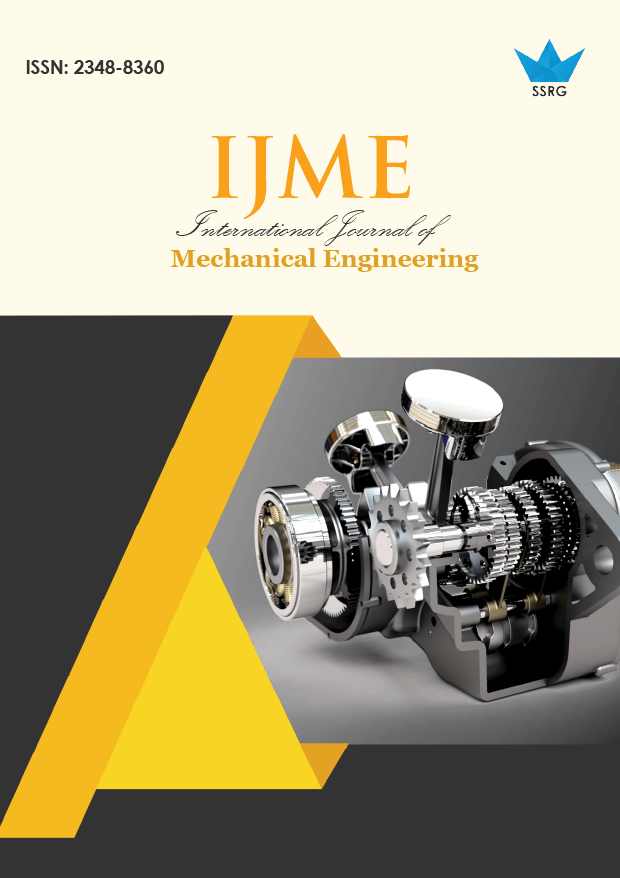Synthesis of Nano-Hydroxyapatite from Sea Shell and Squid Bone Waste for Advanced Bone Applications via Precipitation Process

| International Journal of Mechanical Engineering |
| © 2025 by SSRG - IJME Journal |
| Volume 12 Issue 9 |
| Year of Publication : 2025 |
| Authors : Saravanan M, Sangeetha Krishnamoorthi, Nagalakshmi Rajaram, Saravanakumar M |
How to Cite?
Saravanan M, Sangeetha Krishnamoorthi, Nagalakshmi Rajaram, Saravanakumar M, "Synthesis of Nano-Hydroxyapatite from Sea Shell and Squid Bone Waste for Advanced Bone Applications via Precipitation Process," SSRG International Journal of Mechanical Engineering, vol. 12, no. 9, pp. 130-138, 2025. Crossref, https://doi.org/10.14445/23488360/IJME-V12I9P113
Abstract:
Large quantities of seashells and squid bones are discarded globally as biowaste, leading to serious environmental concerns. This work explores the conversion of these wastes into nano-hydroxyapatite (nHAp) using a simple and sustainable precipitation technique. The aim of the study was to establish an economical synthesis route while assessing the material’s suitability for biomedical applications. Hydroxyapatite is valued for its osteoconductivity - the ability to guide new bone formation and bioactivity- and its capacity to bond with living tissues, making it a promising candidate for bone regeneration. Comprehensive material characterization was carried out through FT-IR, XRD, SEM, TEM and EDAX. The analyses confirmed the development of phase-pure nHAp with uniform hexagonal and rod-like morphologies and high elemental purity. Antibacterial studies demonstrated significant inhibition zones against Listeria and Salmonella, with greater activity observed against Salmonella. The findings demonstrate that dual marine waste sources can be transformed into functional nHAp suitable for biomedical use. Beyond addressing waste management challenges, the study establishes a pathway toward scalable, low-cost biomaterials with potential applications in bone tissue engineering, implants, and regenerative medicine.
Keywords:
Seashell, Squid Bone, Hydroxyapatite, Antibacterial.
References:
[1] Khelendra Agrawal et al., “Synthesis and Characterization of Hydroxyapatite Powder by Sol-Gel Method for Biomedical Application,” Journal of Minerals and Materials Characterization and Engineering, vol. 10, no. 8, pp. 727-734, 2011.
[CrossRef] [Google Scholar] [Publisher Link]
[2] Iwekumo Ebibofe Agbozu, and Omatosan Patrick Wategire, “Evaluation of Extracted Cow Bone Hydroxyapatite,” Scholars International Journal of Chemistry and Material Sciences, vol. 8, no. 3, pp. 138-147, 2025.
[CrossRef] [Google Scholar] [Publisher Link]
[3] Richard E. Riman et al., “Solution Synthesis of Hydroxyapatite Designer Particulates,” Solid State Ionics, vol. 151, no. 1-4, pp. 393-402, 2002.
[CrossRef] [Google Scholar] [Publisher Link]
[4] K. Donadel et al., “Structural, Vibrational and Mechanical Studies of Hydroxyapatite Produced by Wet-Chemical Methods,” Arxiv Preprint, pp. 1-10, 2004.
[CrossRef] [Google Scholar] [Publisher Link]
[5] Shanta Pokhrel, “Hydroxyapatite: Preparation, Properties and Its Biomedical Applications,” Advances in Chemical Engineering and Science, vol. 8, no. 4, pp. 225-240, 2018.
[CrossRef] [Google Scholar] [Publisher Link]
[6] Lubna et al., “Nano Hydroxyapatite in Bone Regeneration: A Literature Review,” World Journal of Advanced Research and Reviews, vol. 16, no. 3, pp. 600-608, 2022.
[CrossRef] [Google Scholar] [Publisher Link]
[7] Dare Victor Abere et al., “Mechanical and Morphological Characterization of Nano-Hydroxyapatite (nHA) for Bone Regeneration: A Mini Review,” Biomedical Engineering Advances, vol. 4, pp. 1-12, 2022.
[CrossRef] [Google Scholar] [Publisher Link]
[8] J.H. Shepherd, R.J. Friederichs, and S.M. Best, 11 - Synthetic Hydroxyapatite for Tissue Engineering Applications, Hydroxyapatite (Hap) for Biomedical Applications, Woodhead Publishing, pp. 235-267, 2015.
[CrossRef] [Google Scholar] [Publisher Link]
[9] Hongjian Zhou, and Jaebeom Lee, “Nanoscale Hydroxyapatite Particles for Bone Tissue Engineering,” Acta Biomaterialia, vol. 7, no. 7, pp. 2769-2781, 2011.
[CrossRef] [Google Scholar] [Publisher Link]
[10] Kalpana S. Katti, “Biomaterials in Total Joint Replacement,” Colloids and Surfaces B: Biointerfaces, vol. 39, no. 3, pp. 133-142, 2004.
[CrossRef] [Google Scholar] [Publisher Link]
[11] Md. Kawcher Alam et al., “Synthesis of Nano-Hydroxyapatite Using Emulsion, Pyrolysis, Combustion, and Sonochemical Methods and Biogenic Sources: A Review,” RSC advances, vol. 14, no. 5, pp. 3548-3559, 2024.
[CrossRef] [Google Scholar] [Publisher Link]
[12] A. Beganskienė et al., “Water Based Sol-Gel Synthesis of Hydroxyapatite,” Materials Science, vol. 9, no. 4, pp. 383-386, 2003.
[Google Scholar] [Publisher Link]
[13] J.M. Coelho et al., “Synthesis and Characterization of HAp Nanorods from a Cationic Surfactant Template Method,” Journal of Materials Science: Materials in Medicine, vol. 21, pp. 2543-2549, 2010.
[CrossRef] [Google Scholar] [Publisher Link]
[14] Sanosh Kunjalukkal Padmanabhan et al., “Sol–Gel Synthesis and Characterization of Hydroxyapatite Nanorods,” Particuology, vol. 7, no. 6, pp. 466-470, 2009.
[CrossRef] [Google Scholar] [Publisher Link]
[15] Feray Bakan, Oral Laçin, and Hanifi Sarac, “A Novel Low Temperature Sol–Gel Synthesis Process for Thermally Stable Nano Crystalline Hydroxyapatite,” Powder Technology, vol. 233, pp. 295-302, 2013.
[CrossRef] [Google Scholar] [Publisher Link]
[16] S. Ramesh et al., “Characteristics and Properties of Hydoxyapatite Derived by Sol–Gel and Wet Chemical Precipitation Methods,” Ceramics International, vol. 41, no. 9, pp. 10434-10441, 2015.
[CrossRef] [Google Scholar] [Publisher Link]
[17] S. Roopalakshmi et al., “Investigation of Structural and Morphological Characteristic of Hydroxyapatite Synthesized by Sol-Gel Process,” Materials Today: Proceedings, vol. 4, no. 11, pp. 12026-12031, 2017.
[CrossRef] [Google Scholar] [Publisher Link]
[18] Obinna Anayo Osuchukwu et al., “Taguchi Grey Relational Optimization of Sol–Gel Derived Hydroxyapatite from a Novel Mix of Two Natural Biowastes for Biomedical Applications,” Scientific Reports, vol. 12, no. 1, pp. 1-17, 2022.
[CrossRef] [Google Scholar] [Publisher Link]
[19] Makoto Otsuka et al., “Mechanochemical Synthesis of Bioactive Material: Effect of Environmental Conditions on the Phase Transformation of Calcium Phosphates During Grinding,” Bio-Medical Materials and Engineering, vol. 4, no. 5, pp. 357-362, 1994.
[CrossRef] [Google Scholar] [Publisher Link]
[20] Tadashi Kokubo, Hyun-Min Kim, and Masakazu Kawashita, “Novel Bioactive Materials with Different Mechanical Properties,” Biomaterials, vol. 24, no. 13, pp. 2161-2175, 2003.
[CrossRef] [Google Scholar] [Publisher Link]

 10.14445/23488360/IJME-V12I9P113
10.14445/23488360/IJME-V12I9P113